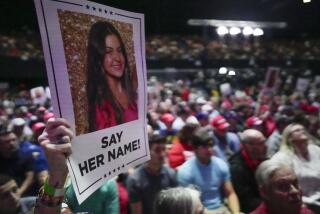Searching for the Life of Riley in Hoosier Country
- Share via
INDIANAPOLIS — In this Hoosier heartland whose inner hub has undergone a remarkable renaissance, the home of the celebrated poet James Whitcomb Riley stands apart.
There is no massive renovation here. Not even minimal restoration. It remains as it was, proclaimed by authorities to be one of the most perfectly preserved Victorian houses in the nation, imparting a detailed view of a genteel life style.
Although not far from the downtown area in Lockerbie Square, a residential neighborhood rescued from decline, the house is almost impossible to find. Repeatedly we asked for directions, only to receive puzzled responses.
After circling a while we finally found it: 528 Lockerbie St. Riley’s description was accurate: Long ago he wrote: “Such a dear little street it is, nestled away from the noise of the city and the heat of the day.”
Unaccustomed to accolades, never could he have foreseen that his cherished home would become the driving force behind exhaustive restoration of the entire district. Unfortunately, in the decades following his death the section was conspicuous for peeling paint, sagging porches, weeds and an aura of decay.
Nor could Riley have predicted his position of esteem in the literary world, coupled with high public regard and affection.
Humble Origins
Born in Greenfield, a small village not many miles east of Indianapolis, on Oct. 7, 1849, Riley’s father was a lawyer and his mother contributed verse to the local paper.
He was an indifferent scholar, receiving barely satisfactory report cards. In his early years he worked as a sign painter and wandering minstrel for a patent-medicine company.
Afterward he spent almost a decade as a newspaperman for the Indianapolis Journal.
In 1893 he moved to Lockerbie Street, where he was to live and compose verse for almost a quarter of a century, abandoning forever the Bohemian life.
“Think of it,” he remarked before he moved in. “I never owned a desk in my life and don’t know what it is to own a library. Where do I write? Everywhere, sometimes on the kitchen table in my sister’s house, then in the parlor and again on the printer’s case. Just where the fancy seizes me.”
A Paying Guest
The stately home answered his need for substance and stability. Built in 1872 with solid brick walls, stone foundation and slate roof, it was here that Riley spent his last 23 years as the paying guest of his dear friends, Maj. and Mrs. Charles L. Holstein.
He shared household expenses and was responsible for the purchase of many of the furnishings. Mrs. Holstein was the daughter of the original owner and builder, John R. Nickum, also a close friend of Riley’s.
A group of Riley’s associates, including Booth Tarkington and George Ade, bought the house and its contents from the estate of Mrs. Holstein soon after her death, three months after Riley died on July 22, 1916.
Walking up the front steps into the long vestibule dominated by a magnificent hall tree, one is caught in another time frame, another culture.
Editorial Advice
James Whitcomb Riley is a big draw. It seems incongruous that back in Greenfield they didn’t think he would amount to much. “Half the town pitied me,” he said. An editor advised him to “discontinue writing.”
The magic of his pen still proves captivating. During two months last summer, guests from 16 countries crossed the threshold of the home.
Reeda Dance, a tour guide, understands the poet’s mystique: “I love this house--I feel like I am part of it--and I can appreciate the greatness of the man.”
In the drawing room, Riley’s cane and guitar rest at the end of a lavish gilt mirror while his violin remains on top of the electric player piano, one of the first of its kind, a gift to Riley from the manufacturer.
“He was an accomplished musician, entertaining people with music as well as poetry,” Dance said. Riley’s niece said she often played the violin in this room with “Uncle Jim” accompanying her on the player piano, and “he thought it great fun.”
Petticoat Mirror
The room is furnished with heavy upholstered pieces displaying an Oriental motif--fabric in a pagoda design. An arched petticoat mirror at the bottom of the fireplace enabled the ladies to check their skirts. The stunning six-globe crystal chandelier, circa 1847, from Paris, was bought by Riley for the house.
The library reportedly was Riley’s favorite room. It holds a collection of his books, a Tiffany lamp, portraits of Riley and his friend, Joel Chandler Harris (author of the Uncle Remus stories), and Riley’s easy chair next to the fireplace.
In the dining room, tooled Austrian leather forms the wainscoting. The massive, hand-carved cherrywood sideboard holds the Tiffany service. Dishes, linens, silver are those that the family used.
The table, set with mulberry-bordered Bavarian china, seems ready for guests. Indeed, they entertained frequently, hosting the literary elite, who praised Riley as their own.
During his struggling young poet stage he met Henry Wadsworth Longfellow, who was both complimentary and encouraging.
Cigars From Cuba
A folksy person, unpretentious in his habits, he probably preferred the smaller dining room that connected with the more formal one. This cozy setting contained his own good-size humidor, where he kept his cigars. An avid cigar smoker, he ordered a year’s supply at a time, shipped from Cuba.
Considered the cook’s domain, the kitchen might have been off-limits to the men of the household, except for the butler, but to visitors it is revealing.
The huge soapstone sink, almost two yards across, with faucets for hot and cold water as well as rainwater, has been returned to its original place after years of service in the laundry room.
A stove complete with warming oven, an ice box with a 100-pound capacity, a pie safe where the housekeeper kept all the goodies, and a cherrywood country table contribute to the utilitarian, no-nonsense decor. On the Hoosier cupboard is a copy of “The Raggedy Man.”
Next to the back door a tiny alcove serves as a minuscule Victorian mud room, “so they could wash up when they came in.” A basin that fits into an opening on the counter top and a pitcher aid in the process. Above, a framed oval window completes the quaint tableau.
Desk in Readiness
Upstairs with a degree of comfort and reverence, Riley’s room appears ready for his return. The desk where he wrote late at night is waiting, with his pen. His beaver hat is on the bed, his white suit in the closet.
One of his most prized possessions, the painting of his pet poodle Lockerbie, hangs above the fireplace. Riley’s self-portrait also adorns the wall. A man of diverse talents, he liked to draw and often illustrated his letters.
Near the window, on brown wrapping paper, one finds the framed original of “Out to Old Aunt Mary’s.” A prolific writer who composed scores of poems, Riley gained popularity for his homespun dialect verses that mingled pathos and humor, capturing the essence of small-town America.
The house is an impressive testimonial of his monetary success--which he nevertheless “deemed unworthy recompense for all the trials and anxieties I must endure.”
Victorian elegance at its prime, the carpeted bath sets forth a statement: the family had arrived. It was one of the first in the city. The tub, encased in cherrywood paneling similar to the lower walls, is tin over copper.
A sculpture porcelain base surrounds the ironstone commode, with a cut-glass handle for the pull chain. Water from wells and cisterns in the backyard was pumped to holding tanks in the attic for use throughout the house.
The James Whitcomb Riley House is open daily except Monday, 10 a.m. to 4 p.m.; Sunday, noon to 4 p.m.
To get to 528 Lockerbie St. from the city’s Monument Circle, drive north on Meridian three blocks to Vermont, turn right, go east five blocks to East Street. Turn right (south), then half a block to Lockerbie Street and turn left again.
More to Read
Sign up for our Book Club newsletter
Get the latest news, events and more from the Los Angeles Times Book Club, and help us get L.A. reading and talking.
You may occasionally receive promotional content from the Los Angeles Times.









